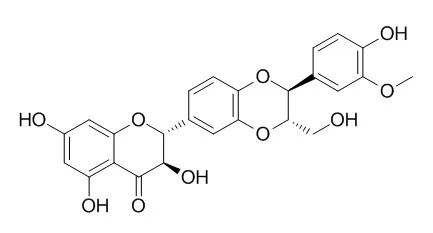| In vitro: |
| PLoS One. 2012;7(4):e34630. | | Angiopreventive efficacy of pure flavonolignans from milk thistle extract against prostate cancer: targeting VEGF-VEGFR signaling.[Pubmed: 22514647 ] | The role of neo-angiogenesis in prostate cancer (PCA) growth and metastasis is well established, but the development of effective and non-toxic pharmacological inhibitors of angiogenesis remains an unaccomplished goal. In this regard, targeting aberrant angiogenesis through non-toxic phytochemicals could be an attractive angiopreventive strategy against PCA.
METHODS AND RESULTS:
The rationale of the present study was to compare the anti-angiogenic potential of four pure diastereoisomeric flavonolignans, namely silybin A, silybin B, isosilybin A and Isosilybin B, which we established previously as biologically active constituents in Milk Thistle extract. Results showed that oral feeding of these flavonolignans (50 and 100 mg/kg body weight) effectively inhibit the growth of advanced human PCA DU145 xenografts. Immunohistochemical analyses revealed that these flavonolignans inhibit tumor angiogenesis biomarkers (CD31 and nestin) and signaling molecules regulating angiogenesis (VEGF, VEGFR1, VEGFR2, phospho-Akt and HIF-1α) without adversely affecting the vessel-count in normal tissues (liver, lung, and kidney) of tumor bearing mice. These flavonolignans also inhibited the microvessel sprouting from mouse dorsal aortas ex vivo, and the VEGF-induced cell proliferation, capillary-like tube formation and invasiveness of human umbilical vein endothelial cells (HUVEC) in vitro. Further studies in HUVEC showed that these diastereoisomers target cell cycle, apoptosis and VEGF-induced signaling cascade. Three dimensional growth assay as well as co-culture invasion and in vitro angiogenesis studies (with HUVEC and DU145 cells) suggested the differential effectiveness of the diastereoisomers toward PCA and endothelial cells.
CONCLUSIONS:
Overall, these studies elucidated the comparative anti-angiogenic efficacy of pure flavonolignans from Milk Thistle and suggest their usefulness in PCA angioprevention. | | Oncogene. 2008 Jun 26;27(28):3986-98. | | Isosilybin B causes androgen receptor degradation in human prostate carcinoma cells via PI3K-Akt-Mdm2-mediated pathway.[Pubmed: 18332867 ] | The identification and development of novel nontoxic phytochemicals that target androgen and androgen receptor (AR) signaling remains a priority for prostate cancer (PCA) control.
METHODS AND RESULTS:
In the present study, we assessed the antiandrogenic efficacy of Isosilybin B employing human PCA LNCaP (mutated AR), 22Rv1 (mutated AR) and LAPC4 (wild-type AR) cells. Isosilybin B (10-90 microM) treatment decreased the AR and prostate specific antigen (PSA) levels in LNCaP, 22Rv1 and LAPC4 cells, but not in non-neoplastic human prostate epithelial PWR-1E cells. Isosilybin B treatment also inhibited synthetic androgen R1881-induced nuclear localization of AR, PSA expression and cell growth, and caused G(1) arrest. In mechanistic studies identifying AR degradation, Isosilybin B caused increased phosphorylation of Akt (Ser-473 and Thr-308) and Mdm2 (Ser-166), which was linked with AR degradation as pretreatment with PI3K inhibitor (LY294002)-restored AR level. Further, overexpression of kinase-dead Akt largely reversed Isosilybin B mediated-AR degradation suggesting a critical role of Akt in AR degradation. Antibody pull-down results also indicated that Isosilybin B treatment enhances the formation of complex between Akt, Mdm2 and AR, which promotes phosphorylation-dependent AR ubiquitination and its degradation by proteasome.
CONCLUSIONS:
Together, present findings identify a novel mechanism for Isosilybin B-mediated anticancer effects in human PCA cells. | | Carcinogenesis. 2007 Jul;28(7):1533-42. | | Isosilybin B and isosilybin A inhibit growth, induce G1 arrest and cause apoptosis in human prostate cancer LNCaP and 22Rv1 cells.[Pubmed: 17389612] | Silymarin and, one of its constituents, silibinin exert strong efficacy against prostate cancer (PCA); however, anticancer efficacy and associated mechanisms of other components of silymarin, which is a mixture of flavonolignans, are largely unknown.
METHODS AND RESULTS:
Here we have assessed the anticancer efficacy of two pure compounds Isosilybin B and isosilybin A, isolated from silymarin, in human prostate carcinoma LNCaP and 22Rv1 cells. Isosilybin B and isosilybin A treatment resulted in growth inhibition and cell death together with a strong G(1) arrest and apoptosis in both the cell lines. In the studies examining changes in cell cycle and apoptosis regulators, Isosilybin B and isosilybin A resulted in a decrease in the levels of both cyclins (D1, D3, E and A) and cyclin-dependent kinases (Cdk2, Cdk4 and cell division cycle 25A), but caused an increase in p21, p27 and p53 levels, except in 22Rv1 cells where Isosilybin B caused a decrease in p21 protein level. Isosilybin B- and isosilybin A-induced apoptosis was accompanied with an increase in the cleavage of poly (ADP-ribose) polymerase, caspase-9 and caspase-3 and a decrease in survivin levels. Compared with LNCaP and 22Rv1 cells, the antiproliferative and cytotoxic potentials of Isosilybin B and isosilybin A were of much lesser magnitude in non-neoplastic human prostate epithelial PWR-1E cells suggesting the transformation-selective effect of these compounds.
CONCLUSIONS:
Together, this study for the first time identified that Isosilybin B and isosilybin A, two diastereoisomers isolated from silymarin, have anti-PCA activity that is mediated via cell cycle arrest and apoptosis induction. |
|






 Cell. 2018 Jan 11;172(1-2):249-261.e12. doi: 10.1016/j.cell.2017.12.019.IF=36.216(2019)
Cell. 2018 Jan 11;172(1-2):249-261.e12. doi: 10.1016/j.cell.2017.12.019.IF=36.216(2019) Cell Metab. 2020 Mar 3;31(3):534-548.e5. doi: 10.1016/j.cmet.2020.01.002.IF=22.415(2019)
Cell Metab. 2020 Mar 3;31(3):534-548.e5. doi: 10.1016/j.cmet.2020.01.002.IF=22.415(2019) Mol Cell. 2017 Nov 16;68(4):673-685.e6. doi: 10.1016/j.molcel.2017.10.022.IF=14.548(2019)
Mol Cell. 2017 Nov 16;68(4):673-685.e6. doi: 10.1016/j.molcel.2017.10.022.IF=14.548(2019)